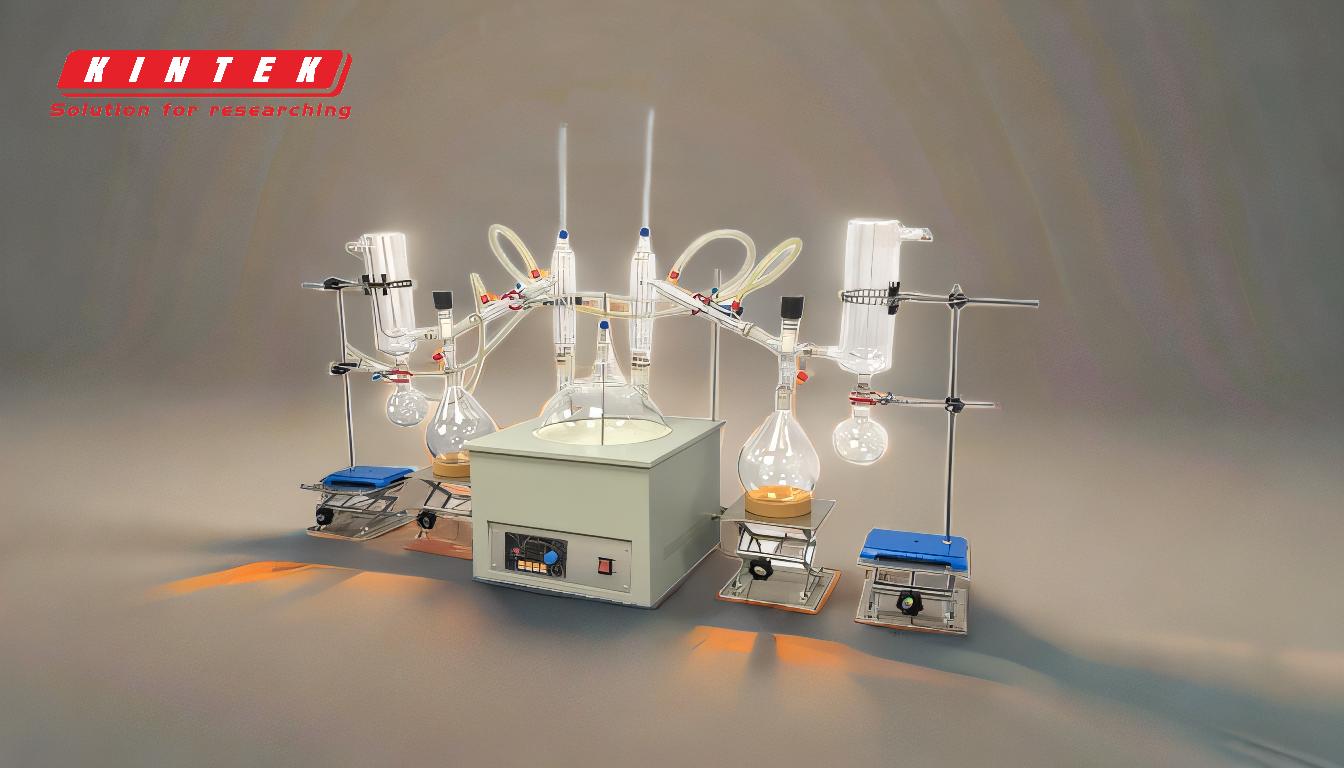Distillation is a process used to separate components of a liquid mixture based on their boiling points. The equipment required for distillation varies depending on the type of distillation being performed, such as fractional, vacuum, or short-path distillation. Common equipment includes a distillation flask, heat source, condenser, receiving flask, and fractionating column. Specialized distillation methods may require additional components like vacuum pumps or wiped film stills. Below is a detailed explanation of the key equipment used in distillation.
Key Points Explained:

-
Distillation Flask:
- The distillation flask (often a round-bottom flask) is where the liquid mixture is placed. It is designed to withstand heat and is connected to other components of the distillation setup. The flask is typically made of heat-resistant glass to ensure safety and durability during heating.
-
Heat Source:
- A heat source is essential to bring the liquid mixture to its boiling point. Common heat sources include:
- Hot plates or heating mantles for controlled heating.
- Hot baths (e.g., water, oil, or sand baths) for uniform heat distribution.
- Direct flame (in some cases), though this requires caution to avoid overheating or cracking the flask.
- A heat source is essential to bring the liquid mixture to its boiling point. Common heat sources include:
-
Condenser:
- The condenser is used to cool the vaporized components back into liquid form. It typically consists of a coiled or straight tube surrounded by a cooling jacket. Common types include:
- Liebig condenser: A simple straight-tube design.
- Graham condenser: A coiled design for more efficient cooling.
- Cooling is achieved by circulating cold water or another coolant through the jacket.
- The condenser is used to cool the vaporized components back into liquid form. It typically consists of a coiled or straight tube surrounded by a cooling jacket. Common types include:
-
Receiving Flask:
- The receiving flask collects the condensed liquid after it passes through the condenser. It is usually a flat-bottom or round-bottom flask made of glass. Multiple receiving flasks may be used if separating multiple fractions.
-
Fractionating Column:
- A fractionating column is used in fractional distillation to separate components with closer boiling points. It provides a large surface area for vapor condensation and re-evaporation, enhancing separation efficiency. Common types include:
- Packed columns: Filled with materials like glass beads or metal rings.
- Plate columns: Contain trays or plates for vapor-liquid contact.
- A fractionating column is used in fractional distillation to separate components with closer boiling points. It provides a large surface area for vapor condensation and re-evaporation, enhancing separation efficiency. Common types include:
-
Thermometer:
- A thermometer is used to monitor the temperature of the vapor during distillation. It is typically placed at the top of the distillation flask or fractionating column to ensure accurate temperature control, which is critical for separating components effectively.
-
Vacuum Pump (for Vacuum Distillation):
- A vacuum pump is used in vacuum distillation to lower the pressure inside the system, thereby reducing the boiling points of the components. This is particularly useful for heat-sensitive compounds that may decompose at higher temperatures.
-
Specialized Equipment for Advanced Distillation:
- Wiped Film Still: Used for high-viscosity or heat-sensitive materials. It employs a rotating wiper to create a thin film of liquid, enhancing evaporation efficiency.
- Molecular Short-Path Still: Designed for high-purity distillation, often used in laboratory settings for small-scale purification.
-
Standard Glassware and Accessories:
- Additional glassware and accessories may include:
- Clamps and stands to secure the setup.
- Connectors and adapters to join components.
- Cooling systems (e.g., recirculating chillers) for condensers.
- Additional glassware and accessories may include:
-
Safety Equipment:
- Safety is paramount in distillation. Essential safety equipment includes:
- Heat-resistant gloves and goggles to protect against burns and splashes.
- Fire extinguishers in case of accidental fires.
- Fume hoods to ventilate hazardous vapors.
- Safety is paramount in distillation. Essential safety equipment includes:
By understanding the role of each piece of equipment, you can select the appropriate setup for your specific distillation needs, whether for simple separations or advanced purification processes.
Summary Table:
| Equipment | Purpose |
|---|---|
| Distillation Flask | Holds the liquid mixture; made of heat-resistant glass. |
| Heat Source | Provides controlled heating (e.g., hot plates, heating mantles). |
| Condenser | Cools vaporized components back into liquid form. |
| Receiving Flask | Collects the condensed liquid after distillation. |
| Fractionating Column | Separates components with close boiling points (e.g., packed or plate columns). |
| Thermometer | Monitors vapor temperature for accurate separation. |
| Vacuum Pump | Lowers pressure for vacuum distillation of heat-sensitive compounds. |
| Wiped Film Still | Enhances evaporation for high-viscosity or heat-sensitive materials. |
| Molecular Short-Path Still | Ensures high-purity distillation in laboratory settings. |
| Safety Equipment | Includes gloves, goggles, fire extinguishers, and fume hoods for protection. |
Ready to set up your distillation process? Contact our experts today for personalized guidance and equipment recommendations!









